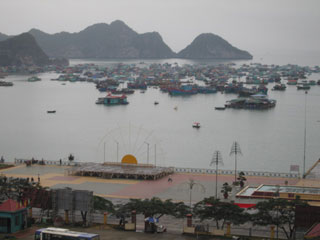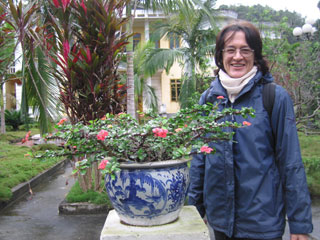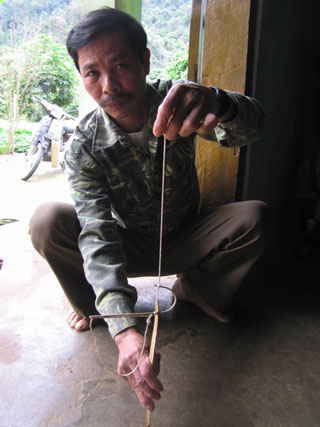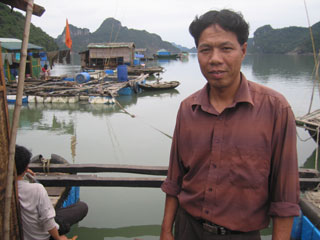CAT BA ISLAND, VIETNAM — What’s an endangered monkey worth?
If it’s a Golden-Maned Langur — found only on Cat Ba Island, off the coast of North Vietnam, a few hours’ drive from Hanoi — the answer is, about a hundred bucks.
The Cat Ba langur is one of the world’s most endangered primate (second only to China’s Hainan Gibbon). There are only 64 Cat Ba langurs left — but that fact doesn’t mean much to poachers.
Before coming to Vietnam, I’d had the impression the monkeys were hunted for their meat; the Vietnamese eat just about everything, including dogs, cats, and porcupines. I was mistaken. Since the langurs eat very tannic leaves, their meat is bitter; it’s usually just thrown away.
The profit is in their bones, which are boiled down to a paste-like consistency, then steeped in rice brandy to make a medicinal tonic called “monkey balm wine.”
“It’s part of the belief that eating jungle creatures will make you powerful,” says Rosie Stenke — a wiry and intense woman who supervises a German project, funded in part by Seacology, to save the langurs. “Especially black creatures. And the Cat Ba langur, though it has golden hair, is mostly black.” A single monkey, she tells me, can net a hunter 1.5 million Vietnam dong: close to $100 U.S. dollars.

Trapping a langur takes luck — and commitment. They’re rare and elusive. A poacher has to be ready to spend days in the jungle, climbing over jagged rocks and fending off snakes, mosquitoes, bees, and centipedes.
It’s illegal to hunt langurs, of course, but enforcement is sketchy: Dr. Stenke and her project serve as the eyes and arms of the law.
Since Rosie is thin and dresses in black I expect her to be manic and cynical, but she’s neither (not to excess, at least). She has been on Cat Ba island for more than five years, and has learned to be a politician as well as a conservationist. This means threading her way through the serpentine bureaucracy and iron-clad customs — many of which involve ritual toasts and drinking — of Vietnam.
Cat Ba is actually an archipelago, consisting of 366 islands. Many are tiny, and very close to the main island. In days past, huge mangrove swamps connected big Cat Ba with its satellites. When the mangroves were cut to build shrimp farms, a handful of langurs ended up marooned on separate isles. At present, the langur population on Cat Ba itself has 60 primates. There is a group of three females on an adjacent island, and one lone female on another. (Eventually, these females will be repatriated to the main group — although exactly how this will be accomplished is not yet clear.)
* * *
My first afternoon on Cat Ba island Rosie and I sit at the Nam Phuong Café, enjoying a lunch of noodles, spring rolls, and strong Vietnamese coffee. I learn a bit of her history. Rosie began her career studying primate behavior, “but once I understood the real issues, I switched to conservation.” She spent 20 months in the Australian outback working with endangered wombats — the world’s largest marsupial — before moving to Vietnam in October 2000 to run the Cat Ba langur conservation project for Germany’s Zoological Society for the Conservation of Species and Populations (ZGAP).
Though Cat Ba is a pretty island, Cat Ba is not an attractive town. There’s a utilitarian feel to the tourism industry, a display of hospitality with little real warmth.

“Two kinds of tourists come here,” says Rosie. “For Asians, it’s all about karaoke, seafood, and, for some, prostitution. For westerners, there’s even less.” The first part of the only hiking trail in the national park was recently paved by the park department, in a misguided attempt to promote tourism. Kayaking has been introduced, but it’s sketchy, as the tides can be extremely low.
One attraction, for visitors like me, is boating between the hundreds of limestone islets, which tower out of the misty bay like tree-shrouded skyscrapers. On good days, it’s like sailing into a traditional Chinese landscape paintings, gliding amidst a panorama of high karst cliffs.
But tourism development, Rosie tells me, affects conservation dramatically. “We have loss of habitat, and habitat fragmentation. Tour guides who have no education take tourists wherever they want; we even had people rock-climbing next to the caves where the langurs sleep. We’re trying to reach an agreement now not to do such tours. That’s why you don’t see much advertising for langurs here. Luckily it’s not easy to see them, either, so tour operators can’t guarantee a sighting.”
Some of the worst impacts on the natural environment have come from infrastructure for tourism — roads and hotels — and fish farms. Though Cat Ba is a UNESCO World Biosphere Reserve, Vietnam’s deputy Prime Minster declared in 2001 that Cat Ba was to be turned into a center for tourism and agriculture. Here, that means seafood farming.
Dividing the primate populations with such activities — road construction, new settlements, dikes and dams for shrimp and fish farms, even a proposed golf course — means cutting off communication between langur groups. This, needless to say, impacts reproductive activity. The situation is made even worse by the fact that the lead males are often the ones who get killed.
When trouble arrives, explains Rosie, “the lead male sits exposed, protecting his harem with obvious display behavior: a very loud call that can be heard for miles, as well as running, jumping and calling. So it’s very easy to shoot them.”
* * *
Cat Ba National Park Headquarters is located 8 miles north of Cat Ba town. The langur project’s offices are housed in a typical “modern” Vietnamese building, built in the French Colonial in style. Rosie introduces me to her assistants. These are two enthusiastic young men — Hung, 25, and Tuyen, 24 — and a willowy British primate conservationist named Sally.
Rosie and I leave her office, and walk along the newly-paved trail leading from park headquarters into the jungle. Bauhinia trees — a favorite of langurs — flower with white blossoms, and tiny frogs hop across the bitumen roadway. Limestone cliffs surround us, vanishing into the fog. These are the flanks of ancient coral reefs, uplifted over the eons and smothered with vegetation.
A self-guided nature loop describes some of the jungle’s greatest hits. I’m especially fascinated by the fish-tail palm, a tree that saved the lives of Cat Ba’s residents during the American War. Haiphong harbor was under siege, and no food was getting to the locals. The palm’s pith has a dough-like consistency, which the islanders used to make breads and cakes.
We talk as we walk. When Rosie arrived on Cat Ba Island, she tells me, there were 52 langurs in existence. Today, there are 64. The increase in numbers is due to an ingenious strategy that involves enlisting high-level commune members and leaders — some former poachers themselves — to serve as guardians for the primates.
“We needed to find people we could trust,” says Rosie. “This means people who have a stable income from a business other than forest exploitation or hunting. Otherwise you put the hawk to guard the chicken house! They also needed to have influence in their community — you can’t take the lowest community member, and put them into a position to protect langurs. So we ended up with people who, in the past, were among the most famous langur hunters. They had incredible knowledge about these animals, as well as a knowledge of the forest.

“The selection process took more than a year,” she sighs, “but now we have three families who are direct langur bodyguards. They keep areas clean of hunters, and patrol jungles outside of the national park. These are our core langur bodyguards.”
These individuals are certified law enforcement agents. They can confiscate boats, destroy hunting equipment, and expel or arrest poachers.
“Isn’t that a bit dangerous?”
“Yes, it is. It’s not often we are successful arresting people — but we do confiscate boats. You see a boat tied to a rock in an area that’s clearly marked as a protected langur area. Depending on what you find in the boat, you can figure out what they’re doing. If they are hunting, our men take the boats while they are still in the forest, so they can’t escape.”
* * *
The Cat Ba langurs are protected on three fronts. The three “first rank” langur guards that Rosie described monitor the steep, slippery jungle trails beyond the reach of the National Park rangers.
Other families, inside the park itself, are more passive; they supplement the rangers’ vigilance, in exchange for floating houses and limited fishing rights. These families are just observers, notifying the rangers when they see something suspicious.
Filling the middle ground between the agents and observers, two teams of forest patrol groups — each with six members — search the jungles for traps and poachers. They don’t have law enforcement permits, but can report illegal activities and confiscate traps.
“The first man we’ll meet,” says Rosie, “is supervisor of one such group.”
A short but thrilling scooter ride between precipitous karst cliffs brings us to the home of Mr. Tinh, a lean, dignified-looking man of fifty-nine. Tinh served in the war — for the North Vietnamese army — and pictures of Ho Chi Minh hang on the walls beside images of Bruce Lee, local starlets, and Cat Ba langurs.
We sit in blue plastic chairs, around a small wooden table. Hung — a cheerful, earnest young conservationist who looks like he could star in a Vietnamese version of Friends — serves as our translator.
Tinh was a hunter for many years, he admits, responsible for the death of dozens of Cat Ba langurs. He’d used “monkey balm wine,” the liquor made with langur bones. “It made me feel much stronger,” he says, flexing his biceps to illustrate the point. “I could work, and walk, for a long time.”
Clearly, Tinh believes the bones have some medicinal powers. What turned him around, from a poacher into a guardian?
“After the project started,” he says, “I realized that the Cat Ba langur is endemic and very rare. Cat Ba is a tourism island, so the langur should be protected for the benefit of tourist activity. I also want to protect them for the next generation, so my grandson will have the chance to see a langur.
“That’s why I go on patrol in the protected areas, to stop violators in their damaging activity. And if I meet a trap, or hunting equipment, I destroy or confiscate it.”
“What if you run into the violators themselves?”
“I visit their families, talk to them, and try to educate them about the need for conservation. If they violate the law again, I inform the forest protection agency.”
Tinh enters the forest twice a week, alone, carrying no weapons save a forest knife. His job is to supervise, quietly, the work being done by his commune’s forest patrol. If he finds evidence of trapping in their survey areas, he knows they’ve been slacking off.
Before we leave, Tinh shows us a recently confiscated trap, an ingenious contraption made of cord and a few slivers of bamboo. He slides his hand through the dangling noose, and it tightens around his wrist. Much as I deplore hunting, I have to admire the simple, effective device.
As a traditional sign of respect, Mr. Tinh pours us each a drink, which he decants from a clear plastic container with a blue screw-on lid. This is “bee’s nest wine,” rice brandy in which a honeycomb has been marinating for a full month — along with the bees.
He fills our glasses again, and again. We can’t refuse, even though the fact that the hive has been harvested from the wild — also an illegal hunting activity — makes de facto poachers of us all.
“Chuc suc khoe!” he cries, as we tip back the honey-sweet elixir. To your health!
I empty my shotglass, pluck a bee from my mouth, and put it in the growing pile next to my notebook.
* * *
At the south end of 20-mile-long Cat Ba island, only 100 yards from the Gia Luan (sha-lun) pier, we board a green motorboat which heads toward a small group of houses rocking on the water. These floating homes are family fish farms: attempts to eke out a bit of income from Cat Ba’s wasp-waist thin economy.

The motorboat (provided, I might add, by Seacology) pulls up along one of the houses — woven rattan walls supporting a blue tin roof. Inside the modest dwelling we meet Mr. Chau, one of Rosie’s three official patrol officers.
Chau, 45, was the very first langur guard hired by Rosie. He knows the animals well; he and his family were professional langur hunters until recently. He became interested in protecting them soon after the project started, he says, and invited Rosie to his home in Gia Luan village. During the meeting, Chau himself proposed the idea of becoming a langur guardian.
“At the beginning of the project, these first rank guardians were required to perform 20 patrols a month,” Rosie recalls. “That’s a lot of time. We couldn’t say, ‘Hey guys, go run through the forest and forget your other income.’ So we use the Seacology funding to pay for boat fuel, for materials to mark the area they protect, and for a small allowance — $50 to $80 a month — to compensate for their loss of income.”
Even in Vietnam, this amounts to a dramatic salary cut. I wonder why people agree to do it in the first place.
“Because they’ve become dedicated conservationists,” Rosie says. “It’s not for money. They do it because they are convinced that the loss of the langur would be a loss to the world.”
Clearly, Chau’s admiration for the primates is genuine. As his brothers prepare lunch — scooping a big silver fish out of the net next to his bedroom — Chau shares a bit of his langur intelligence. The male, he says, often keeps watch on a rock or hilltop, and alerts his harem to any sign of danger. Langurs can also, he assures us, “foresee the weather. If a storm is coming, they sense its arrival well in advance, and move their families into nearby caves and out of danger.”
The concept of “animal rights” is still an abstraction in Vietnam. Chau’s motivation for langur protection is an echo of Tinh’s — preservation for the benefit of human visitors — but he adds an acclamation.
“The most successful protection,” he says, nodding to the project director as she smokes a cigarette in the open doorway, “is from Rosie. She is becoming a Vietnam hero, transferring her awareness to the Vietnamese people. She is an example for them to follow. And she arrived just in time. If the project hadn’t started when it did — five years ago — all the langurs would already be dead.”
Rosie is touched, but she shrugs off the praise. “All we’re doing,” she says, “is opening a window to the future. With a lot of hard work, we’ll manage to keep these langurs alive. What happens afterwards is for the next generation to decide.”
Read Ethical Traveler's Reprint Policy.
